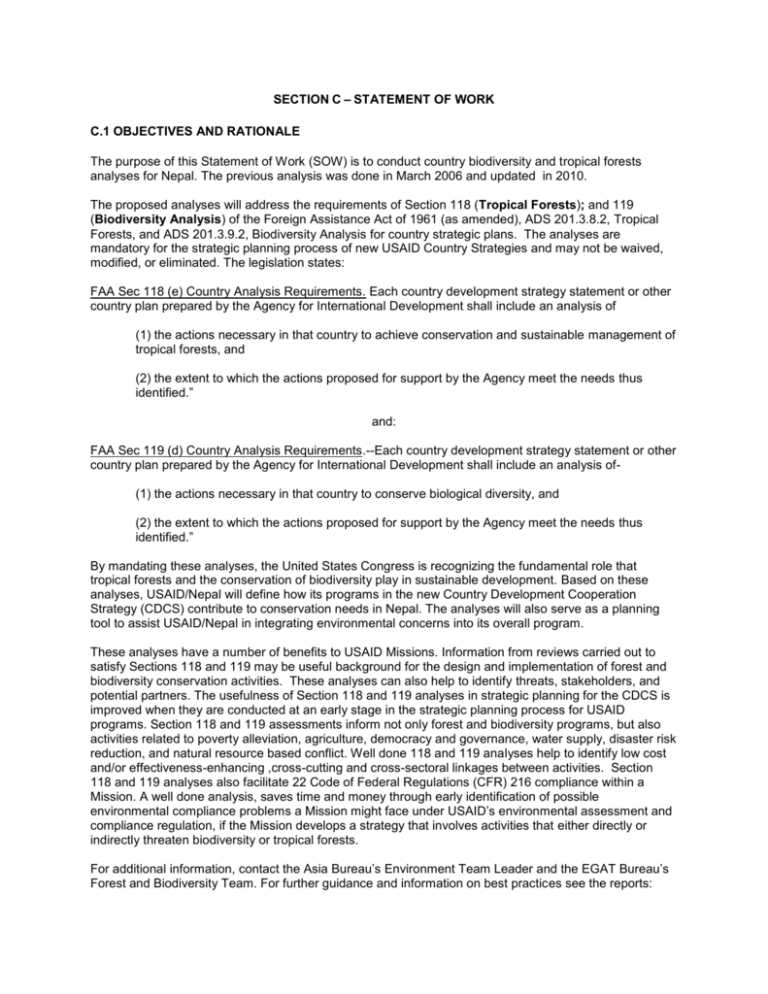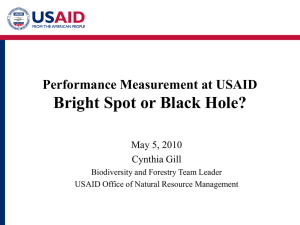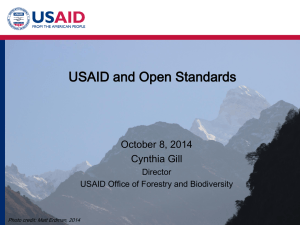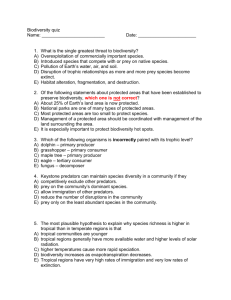Nepal Scope of Work
advertisement

SECTION C – STATEMENT OF WORK C.1 OBJECTIVES AND RATIONALE The purpose of this Statement of Work (SOW) is to conduct country biodiversity and tropical forests analyses for Nepal. The previous analysis was done in March 2006 and updated in 2010. The proposed analyses will address the requirements of Section 118 (Tropical Forests); and 119 (Biodiversity Analysis) of the Foreign Assistance Act of 1961 (as amended), ADS 201.3.8.2, Tropical Forests, and ADS 201.3.9.2, Biodiversity Analysis for country strategic plans. The analyses are mandatory for the strategic planning process of new USAID Country Strategies and may not be waived, modified, or eliminated. The legislation states: FAA Sec 118 (e) Country Analysis Requirements. Each country development strategy statement or other country plan prepared by the Agency for International Development shall include an analysis of (1) the actions necessary in that country to achieve conservation and sustainable management of tropical forests, and (2) the extent to which the actions proposed for support by the Agency meet the needs thus identified.” and: FAA Sec 119 (d) Country Analysis Requirements.--Each country development strategy statement or other country plan prepared by the Agency for International Development shall include an analysis of(1) the actions necessary in that country to conserve biological diversity, and (2) the extent to which the actions proposed for support by the Agency meet the needs thus identified.” By mandating these analyses, the United States Congress is recognizing the fundamental role that tropical forests and the conservation of biodiversity play in sustainable development. Based on these analyses, USAID/Nepal will define how its programs in the new Country Development Cooperation Strategy (CDCS) contribute to conservation needs in Nepal. The analyses will also serve as a planning tool to assist USAID/Nepal in integrating environmental concerns into its overall program. These analyses have a number of benefits to USAID Missions. Information from reviews carried out to satisfy Sections 118 and 119 may be useful background for the design and implementation of forest and biodiversity conservation activities. These analyses can also help to identify threats, stakeholders, and potential partners. The usefulness of Section 118 and 119 analyses in strategic planning for the CDCS is improved when they are conducted at an early stage in the strategic planning process for USAID programs. Section 118 and 119 assessments inform not only forest and biodiversity programs, but also activities related to poverty alleviation, agriculture, democracy and governance, water supply, disaster risk reduction, and natural resource based conflict. Well done 118 and 119 analyses help to identify low cost and/or effectiveness-enhancing ,cross-cutting and cross-sectoral linkages between activities. Section 118 and 119 analyses also facilitate 22 Code of Federal Regulations (CFR) 216 compliance within a Mission. A well done analysis, saves time and money through early identification of possible environmental compliance problems a Mission might face under USAID’s environmental assessment and compliance regulation, if the Mission develops a strategy that involves activities that either directly or indirectly threaten biodiversity or tropical forests. For additional information, contact the Asia Bureau’s Environment Team Leader and the EGAT Bureau’s Forest and Biodiversity Team. For further guidance and information on best practices see the reports: “Tropical Forestry and Biodiversity (FAA 118 and 119) Analyses: Lessons Learned and Best Practices from Recent USAID Experience” and “Best Practices for Biodiversity and Tropical Forest Assessments”. Upon completion of the analyses, the Mission will submit the report to the Bureau’s Environment Team Leader for final approval. C.2. STATEMENT OF WORK Under the direction of a Team leader, the analysis Team and/or Team Leader must evaluate tropical forest and biodiversity concerns in Nepal and must undertake the appropriate synthesis of the information addressing 1) actions necessary to conserve biodiversity, and 2) the extent actions proposed in the country strategic plans (particularly the forthcoming Country Development Cooperation Strategy –CDCS) meet, or could meet, the tropical forest and biodiversity needs thus identified. The latter includes identification of cross-cutting cross-sectoral linkages between proposed activities that would be low cost and/or enhance the effectiveness of proposed activities The analysis Team and/or Team Leader must perform the following activities: A) Data Collection: 1. Prior to departure, get acquainted with already existing background information about Nepal including relevant demographic reports like the 2011 demographic and health survey, the Mission’s 2006 and 2010 Tropical Forest and Biodiversity Analyses (See C.7 for links to previous assessments), Environmental Performance Reports, the National Environmental Action Programs (NEAPs) and the Biodiversity Strategy Action Plan (BSAP), the National Adaptation Plan of Action and other relevant host country and/or donor environmental reviews specific to the country’s natural resources, ecological and biological specificities, current status of tropical forests and biodiversity, climate change and sustainable landscapes, and institutional organizations. The Team and/or Team Leader should become knowledgeable about key stakeholders and donors in tropical forests and biodiversity, legislation related to tropical forests and biodiversity, and other relevant information required for the country analysis. Principal donors include the World Bank, DFID, ADB, SIDA, UNDP, SDC etc. 2. Prior to departure, the contractor shall hold meetings with the Asia Bureau’s Environment Team Leader and Country Desk Officer, and other pertinent USAID Washington Technical Staff to gather relevant information on regional programs and Agency environmental regulations. In addition, meetings shall also be held with relevant United States Government Agencies active in Nepal. 3. Prior to departure, the contractor shall hold meetings with non-governmental organizations (NGOs) suggested by USAID/Nepal. This includes teleconferences to obtain input from the Almaty-based Regional Environment Advisor/Asia and environment staff at USAID’s Regional Development Mission for Asia (RDMA) in Bangkok. 4. The contractor shall, prior to his/her arrival, consult with Mission personnel to identify stakeholders and local officials with whom he/she wishes to conduct the interviews and identify priority site visits. 5. Upon arrival in Nepal, the Contractor under the direction of the Environment and Energy Team Lead at USAID/Nepal will hold meetings with the USAID Mission staff, including the supervisory program officer, to obtain detailed information about the programs, objectives, and goals under the Mission’s current and planned strategy, particularly the CDCS. (It is advisable that the Contractor develop a questionnaire to circulate in the USAID/Nepal Mission prior to arrival to solicit background information and facilitate the preparation process.) (see section J.5 as sample reference). The Contractor and members of the USAID/Nepal’s General Development Office, with input from other offices, such as the Office of Health and Family Planning Environmental Health Team, Disaster Risk Reduction team, the CDCS development team, and the Embassy Regional Environment Office as appropriate will discuss the planned activities required for the analysis as well as the approach that the Contractor will take during the performance on the ground. 6. The Contractor will hold meetings, as agreed with USAID/Nepal’s General Development Office (GDO), with relevant local government institutions, agencies and Ministries. The Contractor will gather information, recommendations and experiences about past and planned activities from the officials and persons directly involved in tropical forest and biodiversity issues. The Contractor will gather detailed information about changes in the country’s specificities, such as protected areas and endangered species since the 2010 report. 7. The Contractor will hold meetings with other international donors, agencies and NGOs involved in tropical forest and biodiversity programs in Nepal and become well informed about ongoing and planned activities by other donors and agencies. B) Analysis: Based upon the review of documents, interviews, and site visits, the Contractor will analyze the following: 1. The status of tropical forests and biodiversity in Nepal, 2. The social, economic, institutional, legal, and policy context for their use and conservation, including actions currently being taken by government, other donors, NGOs, and the private sector. 3. The key direct and indirect threats to tropical forests and biodiversity. 4. The actions necessary to conserve and sustainably manage tropical forests and biodiversity in Nepal in the current context based on analysis of Government, Donor, and NGO responses to meet these needs including identified gaps in knowledge, skills, orientation--at the individual or institutional level. 5. The implications for USAID or other donor programming (as detailed in the CDCS) and environmental monitoring on tropical forests and biodiversity; and 6. Potential recommendations, which shall define the actions for USAID/Nepal to consider ensuring tropical forest and biodiversity conservation. 7. Opportunities for integration with other sectors such as agriculture and food security, water, sanitation and health, and opportunities for education and awareness-raising. 8. The implications of climate change for forest and biodiversity conservation based on climate projections for Nepal and potential for integration of climate change responses within any USAID activities following the USAID Climate Change and Development Strategy. 9. The role of gender in conservation in keeping with USAID’s new gender policy. 10. The capacity and associated enabling environment needed to implement conservation programs. Existing and required capacity should be analyzed at the macro, meso and micro levels. Identify criteria that can be used to measure Nepali organizations for effectiveness and potential impact in the sector. C) Report: Prepare a report describing the analysis and conclusions. This report must meet the legal requirement of FAA Sections 118 and 119 by: (1) clearly articulating the actions necessary to conserve tropical forests and biodiversity in Nepal, and (2) clearly describing the extent to which USAID actions proposed in the new USAID CDCS meets the needs identified. Analysis of gender, climate change and institutional and individual capacity should be incorporated as appropriate throughout the report and listed as separate recommendations as appropriate. The report, of 20-30 pages in length (excluding annexes), shall include sections covering the following topics: Title Page, including the date of completion of the analysis report Table of Contents A. Introduction, describing the purpose of the analysis and methods used in conducting it, including the timing of the analysis in relation to the timing of USAID CDCS. B. An overview of the status of tropical forests and biodiversity in Nepal, including ecosystem diversity, species diversity, threatened & endangered species, genetic diversity, agricultural biodiversity, ecological processes and ecosystem services (including water resources), and values and economics of biodiversity and forests. Highlighting any updates from the 2010 assessment. C. An overview of changes in the social, economic, and political context for sustainable natural resources management and the conservation of biodiversity and forests in Nepal, including the social and economic environment; institutions, policies, and laws affecting conservation; the national protected area system including all IUCN categories of protected areas; laws affecting the protection of endangered species; and participation in international treaties. An updated map of the protected areas system should be provided if available. Describe the institutional framework for environmental, tropical forest and biodiversity management, including organizational set-up at the national and local levels including community forests, relevant legislation and obligations under ratified international environmental agreements and conventions. D. Description of the threats to biodiversity and forests, including direct threats and indirect threats or root causes of the direct threats. E. Provide a list or description of the actions necessary to conserve biodiversity and forests in Nepal, logically flowing from the review of the threats, and what is currently being done by government, NGO, and donor programs that address those threats and recommended actions to address gaps. This should include identification of gaps in knowledge, skills, orientations--at the individual and institutional level--and ways in which these gaps might be addressed. F. A review of government, NGO, and donor programs and activities that contribute to conservation and sustainable natural resources management, and an assessment of their effectiveness, strengths, and weaknesses. Data may be consolidated in a summary table of Donor and NGO projects (w/ $ amounts) since the last report in 2010 (include implemented, ongoing and planned) related to/or impacting biodiversity conservation (direct and indirect). Identify gaps where USAID could best leverage funds. G. Provide a list of key institutions that have demonstrated capacity for achieving results in biodiversity and forestry sector. H. Review of the proposed USAID/Nepal strategy and program, including all Objectives, followed by an analysis of the extent to which actions proposed for support by the USAID/Nepal’s upcoming CDCS correspond to the needs identified in (F) above. This section should also point out any threats to biodiversity and forests from activities proposed for USAID support, and suggest mitigating actions. It should also identify opportunities for cross-cutting, cross-sectoral linkages with proposed activities (for all proposed Objectives and Program Areas); especially those that would be low cost and/or would enhance the effectiveness of the proposed activities. I. Annexes to the report should contain, at minimum: a. A consolidated matrix comparing the current THREATS identified, to ACTIONS needed, with EXTENT TO WHICH USAID addresses threats, & RECOMMENDATIONS for USAID to address threats b. Current IUCN Red List and Nepal Red Book data c. Environment-Related Legislation & Concepts, Plans, Programs, & Strategies (highlight changes since 2010) d. International Conventions and Treaties (highlight changes since 2010) e. The SOW for the analysis f. Biographical sketches of analysis Team members g. A list of persons contacted and their institutional affiliation h. Other background or supporting material as needed such as maps. i. All references used and cited in the report along with URLs used for information resources. C.3. METHODOLOGY Team composition and qualifications: A four to five person team is suggested with the following composition and expertise as required to conduct this analysis: International Technical Assistance (1 person): Senior Level Natural Resource Management Specialist with post-graduate qualifications in biology, zoology, forestry or closely related field in natural resource management or natural resource economics. The consultant will have adequate background in biodiversity and natural resource conservation to complete the FAA 118/119 analysis. Knowledge of USAID Strategic Planning process related to FAA 118 and 119 and knowledge of 22 CFR 216 is also desirable. Demonstrated expertise in assessing development programs for impacts on environment and ecosystems and of environmental impact assessments. Experience in the region and in Nepal desirable. Local Technical Assistance (1 person): Senior Level Natural Resource Management Specialist with demonstrated experience in Nepal environmental law, policy and legal frameworks governing environmental management in Nepal and the analysis of relevant policies and thematic areas (including, but not limited to: biodiversity, forestry, water and/or ecosystem services). Good contacts within the Nepal government agencies, NGOs, international donors, and private sector is preferred. The Nepali member will work only in Nepal. Capacity Building Specialist (1 person): An experienced analyst of individual and institutional capacities at the macro, meso and micro levels. The person should also be familiar and understand how capacity may exist yet there may be weaknesses in the enabling environment, or other weaknesses, including lack of awareness of key needed capacities, lack of resources, commitment etc that prevent capacities from being expressed. Gender Specialist (1 person): An experienced analyst of the role of gender in conservation and/or climate change. Familiarity with USAID’s new Gender Strategy and Gender assessment policies and guidelines is essential. This individual may be identified from USAID pillar or regional bureau support staff. USAID First Tour Officer (1 person): This individual will backstop and provide technical knowledge and administrative support to the FAA 118/119 assessment. Environment /Natural Resource Management training and/or experience conducting 118/119 assessments is highly desirable. It is expected that 1-2 people will be responsible for the desk work, and the full team will participate in the field work. It is expected that there be as many local hire team members as possible or appropriate. C.4. Deliverables: A. The primary deliverable under this task order is a combined Tropical Forests and Biodiversity Analysis Report known as the FAA 118/119 report for USAID/Nepal that examines the tropical forests, biodiversity, natural resource management, the relationship between climate change and forests and biodiversity and other related environmental issues and identifies contributions and/or potential contributions to meet identified conservation needs by the Mission’s proposed strategy. Per FAA, Sec. 118 and 119, the analysis must clearly address the following: (1) a summary of the actions necessary to achieve conservation and sustainable management of tropical forests; and (2) the extent to which the actions proposed meets the identified needs. In addition: (1) the actions necessary in that country to conserve biological diversity; and (2) the extent to which the actions proposed for support by the Agency meet the needs thus identified. B. As this assessment is designed in parallel with the CDCS process in Nepal, the Assessment team is requested to provide a separate 3-5 page technical brief that guides the mission on how to sufficiently address priority issues of biodiversity conservation and sustainable forests management in the CDCS design process. C.5. ANTICIPATED LEVEL OF EFFORT The level of effort (LOE) for this assignment is a total of two months, beginning July 2012 to be allocated among the following as the contractor sees fit to accomplish the SOW: Activity Pre-departure meetings (Washington D.C.) Illustrative Timeline Weeks 1-2 Document review Field activities Drafting and submitting the Report Weeks 1-2 Weeks 3-5 Weeks 6-8 C.6 SCHEDULE AND LOGISTICS Meetings must be held in person or via teleconference with the Asia Bureau’s Environment Team Leader and other pertinent USAID Washington Technical Staff prior to departure. The Contractor’s Team and/or Team Leader will coordinate logistical arrangements with the USAID/Nepal’s Environment Team and prepare a draft schedule of meetings and site visits acceptable to the Mission staff. The Mission will assist the Contractor’s Team by providing key references and contacts and will collaborate in the collection of data as applicable. USAID/Nepal will also help facilitate meetings with donors, host government agencies, and NGOs, as well as other USAID staff to fully brief the Team on USAID's program and future vision for their strategy. An exit briefing will be held with USAID/Nepal Mission Director, Director of GDO, USAID/Nepal, MEO and other relevant Mission Offices/staff to discuss initial findings. A draft report will be submitted to USAID no later than 15 business days from the end of field activities. USAID/Nepal Mission, REA/Asia and the Asia Bureau’s Environment Team Leader and EGAT will review and provide written comments on the draft. The final report is expected within 15 working days of receipt of USAID comments. The contractor will submit the final FAA 118/119 Analysis to USAID/Nepal GDO Office electronically. The Mission will prepare a FAA 118/119 face sheet and submit the final document to the Asia Bureau Environment Team Leader in Washington, DC for approval. Once approved the 118 and 119 2012 report will be posted on the Development Experience Clearinghouse. C.7 ANNEX I: REFERENCES AND DOCUMENTS FOR REVIEW See: http://nepal.usaid.gov/downloads/all-downloads/category/4-economic-growth-education.html See: http://pdf.usaid.gov/pdf_docs/PNADE195.pdf; http://pdf.usaid.gov/pdf_docs/PNADE673.pdf; USAID’s Climate Change and Development Strategy can be found at http://www.usaid.gov/our_work/policy_planning_and_learning/documents/GCCS.pdf http://www.usaid.gov/our_work/policy_planning_and_learning/documents/GenderEqualityPolicy.pdf Previous 118/119 assessments: http://nepal.usaid.gov/downloads/nepal%20tropical%20forestry%20and%20biodiversity%20assessment %20report.pdf http://nepal.usaid.gov/downloads/faa%20118%20%20119%20assessment%20-updated-%202010%20%20updated%20tropical%20forestry.pdf (End of Section C)








